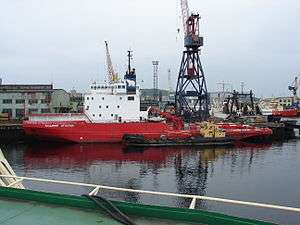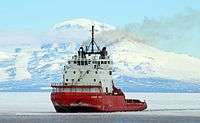Vladimir Ignatyuk (icebreaker)
 Vladimir Ignatyuk | |
| History | |
|---|---|
| Name: |
|
| Namesake: | Head of Murmansk Sea Steamship Lines |
| Operator: |
|
| Ordered: | 1980s |
| Builder: | Burrard Yarrows Co., Victoria, British Columbia |
| Launched: | 1983 |
| In service: | 1983-present |
| Homeport: | Murmansk |
| Status: | In service |
| General characteristics | |
| Type: | Icebreaker |
| Displacement: | 4,234 tonnes (4,667.19 short tons) |
| Length: | 88 m (288 ft 9 in) |
| Beam: | 17.8 m (58 ft 5 in) |
| Draft: | 8.3 m (27 ft 3 in) |
| Ice class: | CASPPR Arctic Class 4 |
| Installed power: | Four Stork-Werkspoor diesel engines, 5,600 hp each |
| Propulsion: | Two shafts; controllable pitch propellers |
| Speed: | 16 knots (30 km/h; 18 mph) |
| Range: | 1,920 nautical miles (3,560 km; 2,210 mi) |
| Endurance: | 58 days |
| Complement: | 24 crew + 10 |
| Aviation facilities: | Forward helicopter deck |
Vladimir Ignatyuk (formerly MV Arctic Kalvik) is a diesel icebreaker that was built in 1983 at the Victoria Yard of the Burrard Yarrows Corporation located in Victoria, British Columbia, Canada for Beaudril Limited, an oil-drilling subsidiary of Gulf Canada Resources Ltd., for use in anchor handling and ice breaking in the Beaufort Sea.[1][2] Two other Class 4 icebreakers were built for Beaudril by Burrard Yarrows Co., Terry Fox and Miscaroo.
History
Launched as Kalvik by the Beaudrill Gulf Limited in 1983, it was renamed to Arctic Kalvik by Fednav Ltd. in 1997. Kalvik was the sister ship to the Terry Fox also built by Burrard Yarrows Corporation of Vancouver, BC, which became a Canadian Coast Guard Heavy Gulf (and Arctic) icebreaker.[3] In 2003, Arctic Kalvik was sold to the JSC Murmansk Shipping Company[4] and was renamed Vladimir Ignatyuk.
Operation

In 2002, Arctic Kalvik and Kigoriak relocated the 146,780 grt arctic drilling platform SDC from Port Clearance to Prudhoe Bay, Alaska.[5]
In August 2011 – 2013, the U.S. National Science Foundation (NSF) chartered Vladimir Ignatyuk to cut the ice and provide escort in McMurdo Sound to vessels supplying the Antarctica's U.S. research stations and field camps.[6][7]
See also
References
- ↑ Icebreaking AHTS –MV Arctic Kalvik
- ↑ Brigham, L. W. (2000). Polar icebreakers at the end of the twentieth century. Polar Record, Vol. 36, Issue 198, July 2000, p. 247-248.
- ↑ Browne, R., J. Carter, and P. Kimmerly. Design, Construction, and First Season's Operation of MV Kalvik and MV Terry Fox. Offshore Technology Conference, 1984.
- ↑ Murmansk Shipping Company
- ↑ An Arctic Tow by ITC. Maritime Journal, 1 Jan 2003.
- ↑ NSF Charters Icebreaker to Support U.S. Research Stations in Antarctica. NSF Press release.
- ↑ Russian icebreaker to help U.S. scientists in Antarctic. RIA NOVOSTI
External links
| Wikimedia Commons has media related to Vladimir Ignatyuk (icebreaker). |
- Vladimir Ignatjuk Murmansk Shipping Co.
- Vladimir Ignatyuk Marine Traffic
- Vladimir Ignatyuk Shipspotting
- MV Arctic Kalvik drawing Shipbucket
- ARCTIC KALVIK - IMO 8127804 Shipspotting
- Tug ARCTIC KALVIK Tugspotters